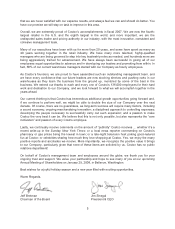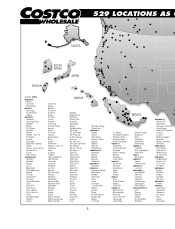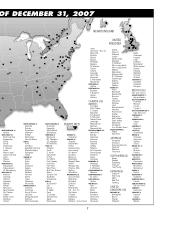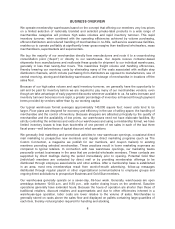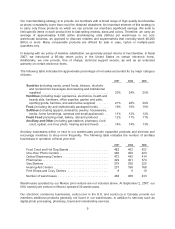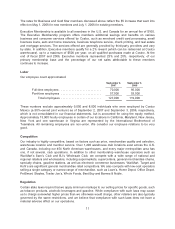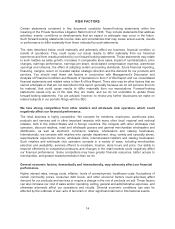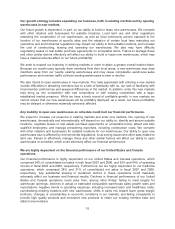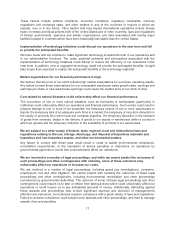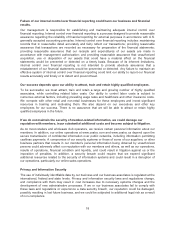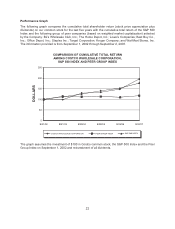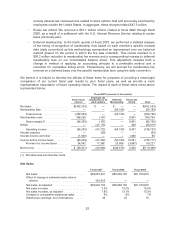Costco 2007 Annual Report Download - page 17
Download and view the complete annual report
Please find page 17 of the 2007 Costco annual report below. You can navigate through the pages in the report by either clicking on the pages listed below, or by using the keyword search tool below to find specific information within the annual report.Our growth strategy includes expanding our business, both in existing markets and by opening
warehouses in new markets.
Our future growth is dependent, in part, on our ability to build or lease new warehouses. We compete
with other retailers and businesses for suitable locations. Local land use and other regulations
restricting the construction of our warehouses, as well as local community actions opposed to the
location of our warehouses at specific sites and the adoption of certain local laws restricting our
operations and environmental regulations may impact our ability to find suitable locations, and increase
the cost of constructing, leasing and operating our warehouses. We also may have difficulty
negotiating leases or real estate purchase agreements on acceptable terms. Failure to manage these
and other similar factors effectively will affect our ability to build or lease new warehouses, which may
have a material adverse affect on our future profitability.
We seek to expand our business in existing markets in order to attain a greater overall market share.
Because our warehouses typically draw members from their local areas, a new warehouse may draw
members away from our nearby existing warehouses and may cause comparable warehouse sales
performance and member traffic at those existing warehouses to slow or decline.
We also intend to open warehouses in new markets. The risks associated with entering a new market
include difficulties in attracting members due to a lack of familiarity with us, our lack of familiarity with
local member preferences and seasonal differences in the market. In addition, entry into new markets
may bring us into competition with new competitors or with existing competitors with a large,
established market presence. While we have a track record of profitable growth, in new markets we
cannot ensure that our new warehouses will be profitably deployed; as a result, our future profitability
may be delayed or otherwise materially adversely affected.
Any inability to open new warehouses on schedule could hurt our financial performance.
We expect to increase our presence in existing markets and enter new markets. Our opening of new
warehouses, domestically and internationally, will depend on our ability to: identify and secure suitable
locations; negotiate leases or real estate purchase agreements on acceptable terms; attract and train
qualified employees; and manage preopening expenses, including construction costs. We compete
with other retailers and businesses for suitable locations for our warehouses. Our ability to open new
warehouses also is affected by environmental regulations, local zoning issues and other laws related to
land use. Failure to effectively manage these and other similar factors will affect our ability to open
warehouses on schedule, which could adversely affect our financial performance.
We are highly dependent on the financial performance of our United States and Canada
operations.
Our financial performance is highly dependent on our United States and Canada operations, which
comprised 94% of consolidated net sales in both fiscal 2007 and 2006, and 93% and 94% of operating
income in fiscal 2007 and 2006, respectively. Furthermore, we are highly dependent on our California
operations, which comprised 28% and 31% of consolidated net sales in fiscal 2007 and 2006,
respectively. Any substantial slowing or sustained decline in these operations could materially
adversely affect our business and financial results. Declines in financial performance of our United
States and Canada operations could arise from, among other things: failing to meet targets for
warehouse openings; declines in actual or estimated comparable warehouse sales growth rates and
expectations; negative trends in operating expenses, including increased labor and healthcare costs;
cannibalizing existing locations with new warehouses; shifts in sales mix toward lower gross margin
products; changes or uncertainties in economic conditions in our markets; and failing consistently to
provide high quality products and innovative new products to retain our existing member base and
attract new members.
15


